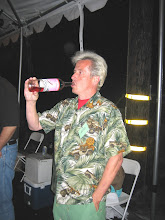Not the first, but likely the second, third or fourth vineyard in California to plant the Spanish variety Verdejo yielded a ton and a half from one acre outside Paso Robles. Nobody seems to have taken the time and trouble to petition the TTB (the Feds) to 'approve' it as a name yet, so it'll be a specially designated Chateau d'Abalone that I will bottle as soon as appropriate (ahem). Exciting!
I'm sure you've all seen vineyard and cellar pictures before, but some of these aren't the usual winery PR.
Coyote Moon vineyard with the Estrella River at the end of the rows. Yes, there is some sunburn on the clusters - it was the second year of a graftover of decade-old Sauvignon Blanc so there wasn't all that much of a canopy. Sugar was just want I wanted (22.7) but the acid numbers would have been appropriate for New Mexico.
Dumping whole clusters into press, note humanoids on right - forklift is twenty feet below.
Two hours to press 253 gallons from 1.6 tons, note juice color. Okay, but have you seen this before?
Top right, juice full of solids from the bottom of the tank (trash); top left, juice with less solids (to be settled, improvisation required because of flat-bottomed tank); bottom, solid CO2, to displace oxygen from the tank until fermentation begins.
This should be obvious, shouldn't it? Colorful captions invited. The smaller the amount of wine made, the more fiddling and fussing required (well, if it's any good). There's a law of diminishing returns dictated by chemistry and physics, which goes a long way to explain why home winemaking has imperfect results.
Thursday, August 30, 2012
Band practice






